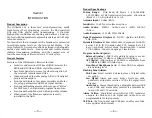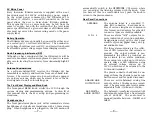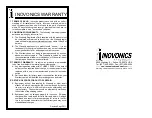
— 7 —
AC Mains Power
Every Inovonics INOmini module is supplied with an out-
board universal, 90-240VAC switching-type power supply.
As the actual power consumed by the INOmini 661 is
335mA at 12 volts DC, a second DC connector on the rear
panel allows the user to ‘daisy-chain’ INOmini
modules.
This means that two or more units may be fed from the
same AC supply, but with the caution that the total input
power specification of a given assortment of INOmini mod-
ules must not exceed the current rating noted on the power
supply label.
Battery Operation
The INOmini 661 may optionally be powered by either a wet
or a sealed (gel) 12-volt lead/acid battery. The nominal in-
put voltage should never exceed 15V, and protection should
be afforded against voltage surges from charging circuits.
Radio Frequency Interference (RFI)
Although we have anticipated that the INOmini 661 will be
used in a broadcast environment, please do practice reason-
able care in locating the unit away from
abnormally
high RF
fields.
Antenna Considerations
As a software-defined DSP receiver, the INOmini 661 has
remarkable sensitivity and freedom from out-of-band inter-
ference. The receiver is meant to be used with an appropri-
ate outdoor antenna, which may be aimed to favor the de-
sired signal or to null an interfering one.
The Front-Panel Display and Menu Knob
The front-panel
MENU
knob scrolls the LCD through the
various viewing and programming options. Section III of
this manual covers the easy setup and programming in-
structions.
Headphone Jack
The front-panel mini-phone jack will accommodate stereo
headphones of virtually any impedance with a 3.5mm stereo
plug. When headphones are plugged in, the LCD menu will
— 8 —
automatically switch to the
HEADPHONE VOL
screen where
you can adjust the listening volume with the knob. Once
you have set this to a comfortable level, push the knob to
return to the previous menu.
Rear Panel Connections
ANTENNA
The antenna input is a standard 75-
ohm BNC connector. Ready-made ca-
bles of various lengths are common in
this format, and adapters for other RF
connector types are readily available.
G D L A
These are alarm “tally” outputs for re-
mote indication of reception problems.
Designations noted on the rear panel
stand for
G
round,
Digital Loss
,
L
ow Sig-
nal and
A
udio Loss.
The three alarm outputs are the collec-
tors of NPN transistors that saturate to
ground. The output polarity is pro-
grammable for either a ground or an
open circuit for an alarm condition.
These outputs can sink up to 100mA to
operate relays or LED indicators using
an external voltage source up to
24VDC, which must be returned to the
G
(Ground) terminal.
The plastic connector body may be un-
plugged from the chassis to make con-
nection easier and for quick disconnect.
ANALOG LINE
OUTPUTS L/R
These are active-balanced analog line
outputs with a 200-ohm source imped-
ance. The program audio level is menu-
adjustable from –15dBu and +15dBu.
AES DIGITAL
AUDIO OUTPUT
The balanced, transformer-isolated AES
digital audio output has a fixed sample
rate of 44.1kHz. The audio level is
menu-adjustable between –30dBFS and
0dBFS.
































